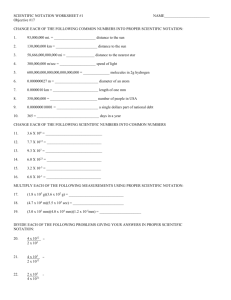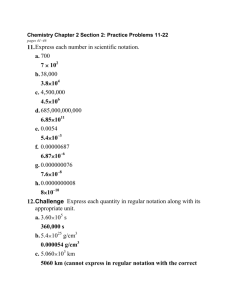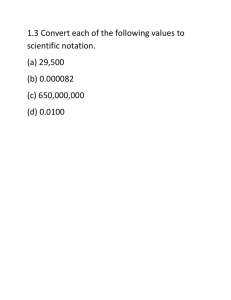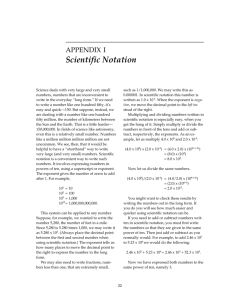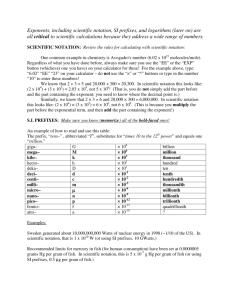Problem Set 1
advertisement
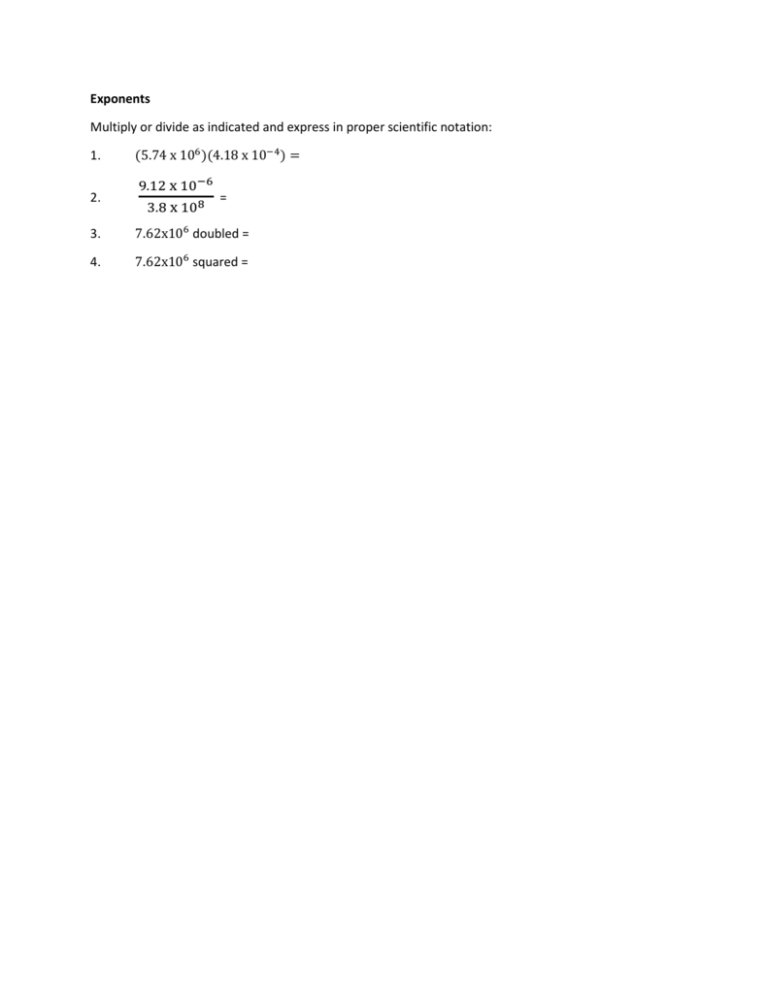
Exponents Multiply or divide as indicated and express in proper scientific notation: 1. 2. ሺ5.74 x 10 ሻሺ4.18 x 10ିସ ሻ = ଽ.ଵଶ ୶ ଵషల ଷ.଼ ୶ ଵఴ = 3. 7.62x10 doubled = 4. 7.62x10 squared = Unit conversions Relevant URLs with additional information and exercises for this topic include: http://www.chem.tamu.edu/class/fyp/mathrev/mr-da.html http://chemistry.alanearhart.org/Old/Tutorials/DimAnal/index.html http://www.felderbooks.com/papers/units.html Refresher: SI notation. The metric system is correctly known as the SI system, which is short for Systeme International d'Unites (International System of Units). The names of these base units are used in conjunction with standard prefixes to refer to different quantities of a particular unit. All metric or SI prefixes refer to powers of 10. The table below lists most of the SI prefixes. SI Prefixes Multiplier Multiplier (numerical) (exponential) (scientific notation) Prefix Symbol tera T 1 trillion 1,000,000,000,000 1012 1×1012 giga G 1 billion 1,000,000,000 109 1×109 mega M 1 million 1,000,000 106 1×106 kilo k 1 thousand 1,000 103 1×103 hecto h 1 hundred 100 102 1×102 deka da 1 ten 10 101 1×101 1 one 1 100 1×100 0.1 10-1 1×10-1 UNIT Meaning Multiplier deci d 1 tenth centi c 1 hundredth 0.01 10-2 1×10-2 milli m 1 thousandth 0.001 10-3 1×10-3 micro* µ 1 millionth 0.000001 10-6 1×10-6 nano n 1 billionth 0.000000001 10-9 1×10-9 pico p 1 trillionth 0.000000000001 10-12 1×10-12 Notes: *The prefix µ, micro, should not cause confusion. The symbol for micro, the Greek letter mu (µ), is commonly used in many scientific fields. The µm, a measure of small distances, is often popularly called the micron. Show all conversion work, including all appropriate units, in the problem solutions. Full credit answers will include conversion work. When appropriate, use scientific notation for your answers. Scientific notation is typically used for numbers greater than 999 and less than 0.001. Convert each of the quantities listed into the requested units. Write your answers in the blanks but make sure to show your work in the spaces provided. 1. 610 m3 = _____________ km3 2. 2.3 g/mm3 = _______________ kg/cm3 3. 144 g/cm3 = ________________ kg/cm3 4. 8.3 cm/y = ____________ mm/d 5. 62 m/s = ______________ mm/d Trigonometry 1. Solve for x: 30° y 2. Solve for y: x 3 cm A B 3. In the figure on the left, ABCD is a square whose side is 3 cm units. Find the length of diagonal AD to the nearest tenth. C D A ladder leans against a building. The foot of the ladder is 6 feet from the building. The ladder reaches a height of 14 feet on the building. 4. Find the length of the ladder to the nearest foot. 5. Find, to the nearest degree, the angle the ladder makes with the ground. Algebra and systems of equations 1. Solve for x: 4x + 5 = -2x + 17 x= 2. Solve the following system of equations for both x and y: 10x – y = 50 5x – 5y = 25 x= y= 3. Factor the following equation as far as you can: z ଷ − z ଶ − 9z + 9


